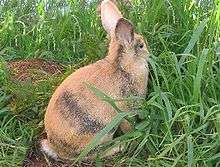Swedish Hare

The Swedish Hare and the Elfin rabbit, were developed simultaneously in Sweden and the United States, specifically for outstanding performance at sporting events for rabbits. Rabbit hopping and Rabbit Agility have become popular and a more competitive animal was desired. In Europe and the United States, breeders began to organize and working standards were in development by 2008. In October 2011, the Elfin rabbits in the United States officially became Swedish Hares.
In Sweden, the landrace breed called the Gotland Rabbit, although rare, was admired for its good temperament and strong bodies. The Gotland rabbit also comes in all colors with many individuals possessing an athletic arched body type. With these qualities in mind to develop the Swedish Hare, good jumpers were bred to the European Polish (like the Britannia Petite in the US), the Belgian Hare and other breeds that were good jumpers and easy to handle.
In the United States several breeds were used in developing the Elfin rabbit. All breeds were considered, using an outgoing temperament and an arched, athletic body type as a guide to individual selection. Large, arched American Rhinelanders were bred to the small Polish breed to reduce the size. Belgian Hares, Tans, Harlequin, Mini Satins, and Britannia Petites were other instrumental breeds. Now that the Elfins have been included in the Swedish Hare population, an international exchange of breeding stock is possible.
Selection for the Swedish Hare is based on criteria directly related to the ability to jump and compete in jumping competitions. Color does not affect jumping ability, so there are NO disqualifications for color or markings. Color does help to tell the competitors apart, so wild and unusual colors are encouraged. The standard selects for the ability to jump in competition and avoids animals that might be hindered by extreme body type, coat, or ear length. Almost all the standard rabbit breeds have individuals that do well in rabbit sports, but Swedish Hares should excel in rabbit sports.
Appearance
For reference, the working Elfin standard calls for a small rabbit weighing no more than 5 lbs, with larger animals of proper type only faulted and not disqualified. General appearance is to be graceful, fully arched and well balanced. The Swedish standard is similar and is being translated into English.
Schedule Of Points
General Type............................................ 75
Fur................................................................... 10
Color............................................................. 5
Condition.................................................... 10
Total............................................................. 100
Showroom Classes & Weights
Senior Bucks & Does—6 months of age and over. Maximum weight 5 pounds.
Junior Bucks & Does—Under 6 months of age.
Note: The Elfin should be judged in a natural position, not posed.
General Type--Points 75: General appearance is to be graceful, fully arched and well balanced. Should be slim, athletic, and well up on their front legs. Body long and fine with a muscular flank well tucked up. Back distinctly arched with the loins and hindquarters well rounded. Neck should be in balance with the body and blending smoothly into the shoulder. Viewed from above the body should taper from shoulders to a slightly wider hip.
Faults—Protruding, flat, or undercut hips; weak shoulders; heavy shoulders. Weight over 5 pounds.
Disqualifications From Competition—Not arch type.
Temperament--Elfin temperament should be alert and active. They should exhibit curiosity and friendliness.
Faults—Any temperament less than gentle, bold and confident. Growling or unwillingness to be handled. Fear.
Disqualifications From Competition—Aggression. Biting. A cranky rabbit having a "bad day" will be disqualified for that day.
Head--The head should medium long and fine, slightly wider between the eyes.
Faults—Wide, round head. Extreme narrowness or pinched muzzle. Weakness.
Ears--Ears should be carried erect and should be in overall balance with the body and legs. Should be roughly the same length as the distance from the base of the ears to the nose. Set well together carried erect on top of the head.
Faults—Excessively long or short ears relative to body. Lopped ears.
Disqualifications From Competition—Ears that interfere with movement or rabbit sports.
Eyes--Bright and bold, well positioned on upper side of head. Any color or combination of color.
Feet and Legs--Fore feet are long, fine in bone and perfectly straight. The hind feet are long, fine and flat. Muscular and strong, in balance with an athletic body.
Faults—Short thick legs, weak legs.
Tail--Straight; length in balance with body.
Fur--Points 10: Flyback coat; should be short and fine and lie very close to the body.
Faults—Any other fur type.
Color--Points 5: Any color is accepted. Attractive.
Disqualifications From Competition—No color or pattern disqualifications. No toenail color disqualifications.
Condition--Points 5: Clean and firm of flesh. The Elfin should appear alert, sprightly and vigorous.
Faults—Obese or underfed.
Sources
- Swedish Hare (in Swedish, but some great photos.)
- Gotland Rabbit (Sweden)
- Gallery of Swedish Hare photos
- Working Elfin standard